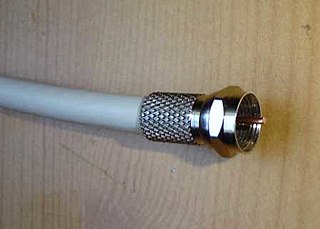Related Research Articles

Cable television is a system of delivering television programming to consumers via radio frequency (RF) signals transmitted through coaxial cables, or in more recent systems, light pulses through fibre-optic cables. This contrasts with broadcast television, in which the television signal is transmitted over-the-air by radio waves and received by a television antenna, or satellite television, in which the television signal is transmitted over-the-air by radio waves from a communications satellite and received by a satellite dish on the roof. FM radio programming, high-speed Internet, telephone services, and similar non-television services may also be provided through these cables. Analog television was standard in the 20th century, but since the 2000s, cable systems have been upgraded to digital cable operation.

British Satellite Broadcasting plc (BSB) was a television company, based in London, that provided direct broadcast satellite television services to the United Kingdom. It started broadcasting on 25 March 1990. The company was merged with Sky Television plc on 2 November 1990 to form British Sky Broadcasting.

Black Entertainment Television (BET) is an American basic cable channel targeting Black American audiences. It is currently owned by the BET Media Group, a subsidiary of Paramount Global's CBS Entertainment Group. Originally launched as a program block on January 25, 1980, BET would eventually become a full-fledged channel on July 1, 1983.

Television in Australia began experimentally as early as 1929 in Melbourne with radio stations 3DB and 3UZ, and 2UE in Sydney, using the Radiovision system by Gilbert Miles and Donald McDonald, and later from other locations, such as Brisbane in 1934.

Cable radio is radio broadcasting into homes and businesses via a cable. This can be a coaxial cable used for television, or a telephone line. It is generally used for the same reason as cable TV was in its early days when it was "community antenna television", in order to enhance the quality of over-the-air radio signals that are difficult to receive in an area. However, cable-only radio outlets also exist. It can be both FM or AM.

There are several different types of mass media in the United Kingdom: television, radio, newspapers, magazines and websites. The United Kingdom is known for its large music industry, along with its new and upcoming artists. The country also has a large broadcasting, film, video games and book publishing industries.

WSMV-TV is a television station in Nashville, Tennessee, United States, affiliated with NBC. It is owned by Gray Television alongside low-power Telemundo affiliate WTNX-LD. The two stations share studios on Knob Road in west Nashville, where WSMV-TV's transmitter is also located.

Sky Television plc was a public limited company which operated a nine-channel satellite television service, launched by Rupert Murdoch's News International on 5 February 1989. Sky Television and its rival British Satellite Broadcasting suffered large financial losses, and merged on 2 November 1990 to form British Sky Broadcasting. A programming merger took effect on 1 December 1990.

WMNT-CD is a low-power, Class A television station in Toledo, Ohio, United States, affiliated with MyNetworkTV. The station is owned by Community Broadcast Group, Inc. WMNT-CD's studios are located in a strip mall at the corner of Reynolds Road and Dussel Drive in Maumee, and its transmitter is located on top of the One SeaGate tower in downtown Toledo.

WEVU-LP, VHF analog channel 4, was a low-power television station licensed to Fort Myers, Florida, United States. The station was owned by Silver Point Capital, and was a satellite of Univision affiliate WUVF-LP.
Cable television first became available in the United States in 1948. By 1989, 53 million U.S. households received cable television subscriptions, with 60 percent of all U.S. households doing so in 1992. Most cable viewers in the U.S. reside in the suburbs and tend to be middle class; cable television is less common in low income, urban, and rural areas.
Cablevision was an American cable television operator with systems serving areas surrounding New York City.

Turner Classic Movies was an Asian digital classic film channel featuring commercial-free classic movies, mostly from the Turner Entertainment and Warner Bros. film libraries, which include many MGM titles. It was the Asian version of the US Turner Classic Movies and aired in the Indian Subcontinent, Southeast Asia and Middle East.
Wire TV was a British cable television channel produced by United Artists Cable and featured a range of entertainment, lifestyle and sports programming. Branded as "The Cable Network" was originally set up and funded with £25 million by Cable Program Partners (CPP1), a consortium of British cable operators including NYNEX, US West and Comcast to bolster alternative content from the satellite-dominated multichannel environment of the time.

Sheffield Cablevision was a cable television community channel in Sheffield, England which launched on 29 August 1973. The channel was one of five community cable television experiments that were authorised by the UK's Minister for Posts and Telecommunications in 1972. It closed on 2 January 1976 due to lack of funds.
Greenwich Cablevision was the first community television station in Britain, broadcasting briefly in the Greenwich area of London during the 1970s.
Bristol Channel was a cable television broadcaster that operated in the Bristol area of England during a period of experimental licensing of cable community television in the 1970s. It was run by Rediffusion and existed from 17 May 1973 to March 1975.

Mustard TV was a local television station based in Norwich, Norfolk. It broadcast to over 400,000 people, covering Norwich and much of Norfolk reaching Cromer in the north of the county, Dereham to the west and parts of south Norfolk and north Suffolk. It was a wholly owned subsidiary of regional media group Archant and was one of 19 initial local TV stations awarded licences by UK broadcasting regulator Ofcom.
This is a timeline of cable television in the United Kingdom.
This is a timeline of local television in the United Kingdom. This refers to stations transmitting to a small area such as a city or part of a county, not to larger regions covered by ITV and BBC regions.
References
- ↑ "Community cable experiments". Terra Media. 30 January 2006.
- ↑ Allen, Rod; Miller, Nod (2002). "Panaceas and Promises of Democratic Participation: Reactions to new channels, from the wireless to the World Wide Web". In Henwood, Flis; Miller, Nod; Senker, Peter; Wyatt, Sally (eds.). Technology and In/equality: Questioning the Information Society. Routledge. pp. 52–53. ISBN 9780203134504.
- ↑ Fiddick, Peter (24 March 1975). "The truth implicit in Rediffusion's pull-out". The Guardian. p. 8.